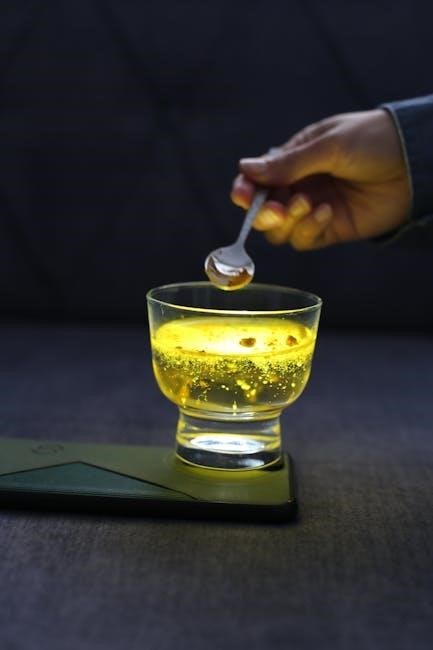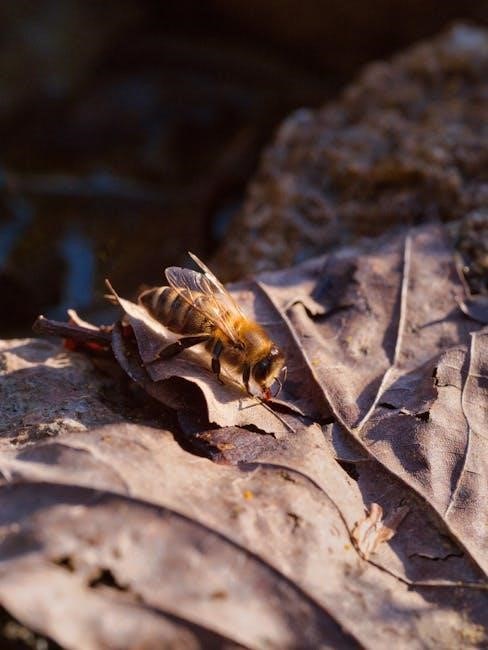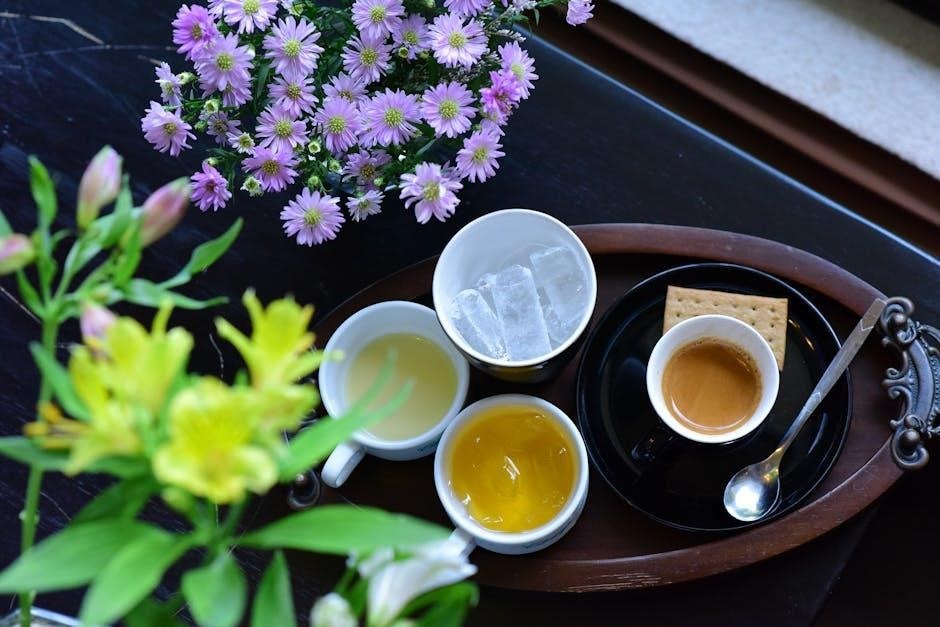
Mad honey, or bitter honey, is a reddish-brown honey with a sharp taste, sourced from Rhododendron flowers. It’s valued in traditional medicine for treating gastric disorders, hypertension, and as an aphrodisiac, though it contains grayanotoxins that can cause poisoning, making it a culturally significant yet risky natural product;
1.1 Definition and Overview
Mad honey, also known as bitter honey, is a distinct type of honey produced from the nectar of Rhododendron flowers. It is characterized by its reddish-brown color, sharp taste, and irritating throat sensation; Traditionally used in medicine, it is valued for treating gastric disorders, hypertension, and sexual dysfunction, though its toxicity poses significant health risks if consumed improperly.
1.2 Historical Significance
Mad honey has been documented historically for its medicinal and strategic uses. Ancient accounts, such as those by Dioscurides and Pliny the Elder, highlight its healing properties. It was notably used by King Mithradates IV as a weapon, showcasing its dual role in history as both a therapeutic agent and a tool for warfare.
1.3 Geographic Distribution
Mad honey is primarily sourced from regions with Rhododendron flowers, such as Nepal, Turkey, and the Himalayas. It is also found in Brazil, Japan, Europe, North America, and parts of Asia. The Black Sea coastal region of Turkey is particularly known for its mad honey production, making it a globally distributed yet regionally specific natural product.
Origin and Production
Mad honey originates from the nectar of Rhododendron flowers, primarily in Nepal, Turkey, and the Himalayas. It is produced by honeybees like Apis laboriosa, known for its potent grayanotoxins, and is highly valued in traditional medicine.
2.1 Sources of Mad Honey
Mad honey is primarily sourced from the nectar of Rhododendron species, such as R. ponticum and R. luteum, found in high-altitude regions like the Himalayas, Nepal, and Turkey. These flowers contain grayanotoxins, which give the honey its unique properties and potential toxicity. Harvesting is typically done by indigenous communities, often in remote and challenging terrains.
2.2 The Role of Rhododendron Flowers
Rhododendron flowers, particularly Rhododendron ponticum and Rhododendron luteum, are the primary source of mad honey’s unique properties. Their nectar contains grayanotoxins, which are responsible for the honey’s toxicity and distinctive taste. These flowers thrive in high-altitude regions like Turkey and Nepal, making them the cornerstone of mad honey production and its medicinal applications.
2.3 Bee Species Involved
The Himalayan giant honey bee (Apis laboriosa) is the primary species responsible for producing mad honey. These bees collect nectar from Rhododendron flowers in high-altitude ecosystems, contributing to the unique chemical composition of the honey. Their role is crucial in maintaining the ecological balance and cultural practices surrounding mad honey production.
Chemical Composition
Mad honey contains grayanotoxins, potent compounds from Rhododendron nectar, along with phenolic compounds, flavonoids, and antioxidants. These constituents contribute to its unique toxicity and potential health benefits.
3.1 Grayanotoxins: The Key Toxin
Grayanotoxins are the primary toxic compounds in mad honey, derived from Rhododendron flowers. These bioactive molecules cause mad honey poisoning, leading to symptoms like nausea, dizziness, and bradycardia. Grayanotoxins work by disrupting ion channels, affecting the nervous system. They are responsible for both the medicinal properties and the risks associated with mad honey consumption, making them a critical area of study.
3.2 Other Bioactive Compounds
Mad honey contains antioxidants, flavonoids, and phenolic compounds, contributing to its medicinal properties. These bioactive molecules, derived from Rhododendron nectar, exhibit antimicrobial and anti-inflammatory effects. They enhance the honey’s therapeutic potential, supporting its traditional use in treating hypertension and digestive disorders. However, their interaction with grayanotoxins can also amplify risks, making moderation essential for safe consumption.

Traditional and Medicinal Uses
Mad honey is traditionally used to treat gastric pains, bowel disorders, and hypertension. It’s also valued as an aphrodisiac and in alternative medicine for sexual dysfunction.
4.1 Historical Medical Applications
Historically, mad honey was valued for its medicinal properties. Dioscurides noted its use in treating sunburns and bruises, while Pliny the Elder highlighted its role in remedies for indispositions. Ancient cultures used it to address gastric issues, hypertension, and sexual dysfunction, showcasing its versatile application in traditional medicine across centuries.
In modern alternative medicine, mad honey is sought for its potential health benefits. It’s used to treat asthma, gastrointestinal diseases, and hypertension, with some studies suggesting antiradical and anti-inflammatory properties. Additionally, its popularity as an aphrodisiac continues, driven by cultural beliefs and anecdotal evidence, though its toxicity necessitates cautious use and regulation. Mad honey poisoning occurs due to grayanotoxins, causing symptoms like nausea, dizziness, and vomiting. It has been historically documented in various regions worldwide. Mad honey poisoning leads to symptoms such as nausea, vomiting, dizziness, and throat irritation. In severe cases, it can cause bradycardia, hypotension, and even loss of consciousness. Symptoms typically appear within hours of consumption, with the severity depending on the amount and toxicity of the honey ingested. Prompt medical attention is essential to manage these effects effectively. Treatment involves supportive care, including hydration and monitoring of vital signs. Activated charcoal may be administered to reduce toxin absorption. In severe cases, atropine and other medications are used to manage bradycardia and hypotension. Early intervention is crucial to prevent complications, with recovery typically occurring within 24-48 hours if proper medical care is provided promptly. Mad honey holds significant cultural value in regional traditions and is sought after for its medicinal properties, driving global demand and shaping local economies through specialized trade. Mad honey is deeply rooted in regional cultures, particularly in Turkey’s Black Sea area, where it’s used in traditional medicine and rituals. Its unique properties make it a sought-after product for health and cultural practices, with high demand in regions like South Korea, despite import bans. This cultural significance drives its global trade and economic influence. Mad honey’s economic impact is significant, with high demand in regions like South Korea and Turkey. Its trade is influenced by its rarity and cultural value, leading to strict regulations. Despite bans in some countries, its global market persists, driven by traditional medicine and alternative health trends, making it a valuable but contentious commodity. Scientific investigations focus on mad honey’s unique properties, including grayanotoxins and antimicrobial activity. Studies explore its effects on health, toxicity, and potential benefits, driving global research interest. Research on mad honey centers on its unique chemical composition, particularly grayanotoxins, and their effects on human health. Studies explore its toxicity mechanisms, antioxidant properties, and potential medicinal applications, while also investigating the role of Rhododendron flowers and specific bee species in its production. These investigations aim to balance its risks and benefits for safe usage. Recent studies focus on mad honey’s antimicrobial and antioxidant properties, exploring its potential in developing new antibiotics. Researchers are also investigating sustainable harvesting practices to preserve ecosystems while maintaining honey production. Advances in toxicology aim to mitigate poisoning risks, ensuring safer use of this unique natural product. Mad honey’s grayanotoxins pose health risks, including nausea and heart issues. Proper dosage, medical supervision, and avoiding use by vulnerable groups are crucial safety measures. Consuming mad honey can lead to severe health issues due to grayanotoxins, including nausea, dizziness, vomiting, and cardiovascular problems like bradycardia. In extreme cases, it may cause respiratory failure or even death. These risks highlight the importance of cautious consumption and medical supervision, especially for individuals with pre-existing heart conditions. To minimize risks, consume mad honey in moderation. Start with a small amount to assess tolerance. Consult healthcare professionals before use, especially for those with heart conditions. Ensure the honey is sourced from trusted producers to verify quality. Be aware of potential allergic reactions and avoid consumption if unsure. Proper handling and storage are crucial to prevent contamination and maintain safety. The trade of mad honey is regulated due to its potential toxicity. Some countries have banned its import, while others enforce strict quality control measures to ensure safety and authenticity. The trade of mad honey is tightly regulated globally to prevent health risks. Many countries enforce strict import bans or require certification to ensure safety. In South Korea, imports were banned in 2005. Quality control measures are mandatory to verify authenticity and reduce toxicity risks. These regulations aim to balance cultural demand with public health protection. Stringent quality control measures for mad honey involve testing for grayanotoxin levels, ensuring they are within safe limits. Laboratories verify the honey’s origin and purity, often tracing it back to regions like the Himalayas or Turkey. These measures help maintain consumer trust while safeguarding against potential health hazards associated with its consumption. Mad honey production relies on Rhododendron-rich ecosystems, primarily in high-altitude regions like the Himalayas and Turkey. Sustainable harvesting practices are crucial to protect these fragile environments. Mad honey production depends on Rhododendron-rich ecosystems, often found in high-altitude regions like the Himalayas and Turkey. Overharvesting can disrupt local biodiversity and threaten these fragile ecosystems. Conservation efforts are essential to protect pollinators and maintain ecological balance, ensuring the sustainability of both the environment and mad honey production.
Sustainable harvesting involves regulating honey extraction to avoid depleting bee colonies and preserving Rhododendron habitats. Beekeepers are encouraged to leave sufficient honey for bees and rotate harvest sites to maintain ecosystem health. Education and certification programs promote eco-friendly practices, ensuring long-term availability of mad honey while safeguarding the environment and local wildlife. Educational campaigns highlight the risks and benefits of mad honey, emphasizing safe usage and awareness of intoxication symptoms. Community outreach programs engage locals in responsible harvesting and consumption practices, promoting public health and environmental stewardship. Educational campaigns on mad honey focus on raising awareness about its safe use, potential risks, and symptoms of poisoning. These initiatives often target communities where mad honey is commonly used, providing resources on proper handling, consumption guidelines, and emergency response. Workshops and materials are distributed to ensure public understanding and mitigate health risks associated with its consumption. Community outreach programs focus on engaging local populations in regions where mad honey is prevalent. These initiatives collaborate with local leaders to educate communities about safe practices, risks, and benefits. Workshops and materials are distributed to promote awareness, while involving healthcare providers ensures timely medical intervention. Such programs aim to reduce poisoning incidents and foster sustainable use of mad honey. Mad honey, valued for its unique properties, poses risks but offers medicinal potential. Future research may uncover new therapeutic uses, balancing safety with traditional benefits. Mad honey, a unique honey with medicinal and cultural significance, is derived from Rhododendron nectar. It contains grayanotoxins, causing intoxication but also offering therapeutic benefits. Historically used for health issues, its risks and benefits highlight the need for cautious use and further research to optimize its potential while ensuring safety and sustainability in traditional and modern applications. Future research may focus on harnessing grayanotoxins for medical applications, such as pain management or neurodegenerative diseases. Sustainable harvesting practices could ensure the preservation of Rhododendron ecosystems. Advances in quality control and toxicity testing may expand safe commercial use. Additionally, studies on mad honey’s antimicrobial properties could lead to new therapeutic products, blending tradition with modern science for global health benefits.4.2 Modern Alternative Medicine Uses

Mad Honey Poisoning
5.1 Symptoms of Intoxication
5.2 Treatment and Management

Cultural and Economic Significance
6.1 Regional Cultures and Mad Honey
6.2 Economic Impact and Trade

Research and Studies
7.1 Scientific Investigations
7.2 Emerging Research Trends
Risks and Safety Measures
8.1 Health Risks Associated
8.2 Safe Usage Guidelines

Legal and Regulatory Aspects
9.1 Regulations on Trade
9.2 Quality Control Measures

Environmental Considerations
10.1 Impact on Ecosystems
10.2 Sustainable Harvesting Practices
Public Awareness and Education
11.1 Educational Campaigns
11.2 Community Outreach Programs
12.1 Summary of Key Points
12.2 Potential Future Developments